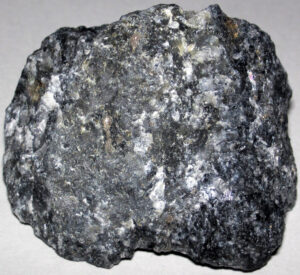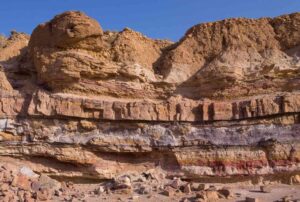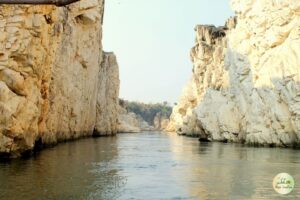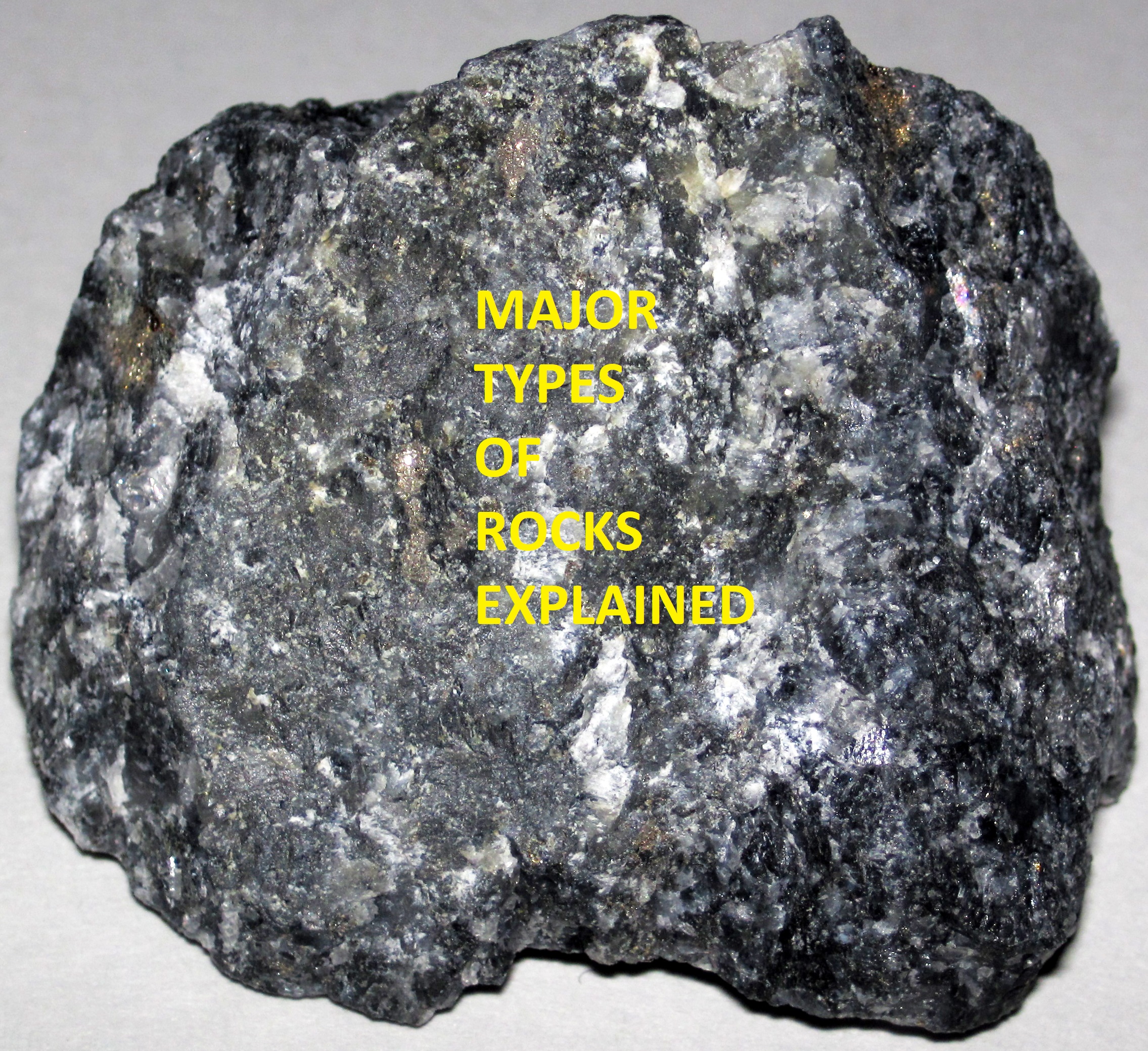The Three Major Types of Rocks: Their Formation & Characteristics
The three major types of rocks are the Earth’s silent storytellers. The three major types of rocks are the Igneous, Sedimentary and Metamorphic. These rocks under and over the earth preserve the secrets of our planet’s geological history. Moreover, these are the building blocks of our planet’s surface. The story of these three types of rocks is extremely interesting. In this article, we will explore the three major types of rocks and delve into their formation processes and unique characteristics.
The Three Major Types of Rocks: Their Formation & Characteristics
Igneous Rocks

courtesy: Wikipedia
The volcano erupts.
The hot molten magma or lava comes out from the earth.
When this hot lava cools down, it becomes very hard like a rock.
Such rocks are known as Igneous rocks.
Therefore, you can say that Igneous rocks are formed by the solidification and cooling of molten rock material known as magma or lava.
Types Of Igneous Rocks:
On the basis of their formation and location, Igneous rocks are of two types – Intrusive Igneous rocks and Extrusive igneous rocks.
Intrusive Igneous Rocks:
Formation:
In means inside.
Intrusive rocks means rocks formed inside the earth.
When the magma inside the earth does not come out and gets solidified, it is known as Intrusive Igneous rocks.
They are formed inside the earth. Slow cooling allows larger mineral crystals to develop.
Characteristics:
These rocks are extremely hard.
These rocks tend to be coarse grained.
As these rocks are hard therefore also used in the construction work.
Common examples are granite and diorite.
Extrusive Igneous Rocks:
Formation:
Ex means outside.
Extrusive rocks means rocks formed (outside) on the surface of the earth.
When the magma inside the earth comes out, it is known as lava.
Quickly cooling of lava on the surface of the earth is known as extrusive Igneous rocks.
They are formed outside the earth. Quickly cooling allows finer mineral crystals to develop.
Characteristics:
These rocks are fine grained.
These rocks tend to have glassy texture and can contain air bubbles due to rapid cooling process..
Common examples are basalt and pumice.
Where can we find these rocks in India?
The deccan trap is mainly formed from the Igneous rocks.
The Three Major Types of Rocks: Their Formation & Characteristics
Sedimentary Rocks

Image courtesy: ThoughtCo
Let’s understand sedimentary rocks with an example.
The river deposits fine sediments everyday.
Due to continuous deposition, the layer of sediments become thick.
When the sediments become thick, it also becomes heavy.
Due to the weight, the sediments stick and become solid.
Thus, sedimentary rocks are formed.
Sedimentary rocks are the result of the accumulation and consolidation of sediments.
You can easily see different layers in sedimentary rocks.
These rocks often include tiny mineral particles, organic materials such as fish bones and chemical precipitates.
These rocks often provide valuable insights into Earth’s history.
Formation:
Sedimentary rocks form through a series of steps.
These steps involve weathering and erosion, transportation, deposition, compaction, and cementation.
Characteristics:
They are typically layered and contain fossils.
These rocks are very crucial for studying the history of life on Earth.
Examples of such rocks are limestone, sandstone, and shale.
Where can we find these rocks in India?
Sedimentary rocks are found in the Indo-Gangetic and coastal plains.
However, sandstones are also found in Eastern Rajasthan, Madhya Pradesh, Himalayas, Bihar and Orissa.
The Three Major Types of Rocks: Their Formation & Characteristics
Metamorphic Rocks:

Image Courtesy: The India
Let’s understand this with a common example.
Observe your mother in the kitchen when she prepares chapati to understand the formation of metamorphic rocks.
Firstly, she takes some flour (Aata)
Flour are like sediments (fine particles).
Secondly, she adds some water and mash.
All sediments join together to form dough (sedimentary rock).
Now, she takes a part of dough and apply pressure to give it round shape.
Finally, after applying pressure, now she places the dough on hot plate and applies high temperature.
Due to high pressure and high temperature, the original form of dough changes into chapati.
once changed, now it can not be brought to its original form.
This process of change in form is called metamorphosis.
Similarly, When sedimentary or metamorphic rock remain under intense heat and pressure for a very long time, it’s original form changes.
For example, the chalk in the hands of your teacher is a sedimentary rock known as limestone.
If kept inside the earth under high temperature and pressure for a very long period, it will turn into marble.
Metamorphic rocks are formed from pre-existing rocks that have undergone intense heat and pressure, causing their mineral structure and texture to change without melting. This transformation often occurs deep within the Earth’s crust.
Formation:
Firstly, Metamorphic rocks form through a process called metamorphism.
Secondly, this involves heat and pressure.
It can happen due to tectonic plate movements, burial, or contact with molten rock.
Characteristics:
Metamorphic rocks, like marble and schist, have a distinct foliated texture with aligned mineral grains.
They are often more durable and can be used in sculptures and countertops.
Where can we find these rocks in India?
Metamorphic rocks are found in Himalayas, Madhya Pradesh, Rajasthan, Bihar and Orissa.
Marble is especially found in Rajasthan and Narmada Valley.
Rock Cycle:
The rock cycle is like a big recycling system for rocks on Earth.
It’s a way rocks change from one type to another over a really, really long time. Let me explain it in simple words.
Imagine you have a big rock.
Do you know that the same rock can change into different types of rocks through the rock cycle.
Igneous rocks are made from the melted rock material called lava that cools and becomes hard.
It’s the same like when you cool down hot chocolate, and it becomes solid again
Similarly, Sedimentary Rocks are made from tiny pieces of other rocks called sediments.
It can also be the shells, or even plant material that have been pressed together over time.
When these sediments compress over time, it becomes sedimentary rocks.
In the same way, when the Igneous or the sedimentary rocks (due to heat and pressure) change its original form, it becomes Metamorphic rocks.
It’s like when you press a crayon with your hand, and it changes shape.
How the cycle works:
Igneous rocks
Igneous rocks are also known as primary rocks or the parent rocks.
It can turn into sedimentary rocks if they break into small pieces and get squished together over time.
Sedimentary rocks:
Similarly, Sedimentary rocks can change into metamorphic rocks if they get buried deep in the Earth and feel lots of heat and pressure.
Metamorphic rocks:
Metamorphic rocks, due to earthquake, volcanic eruption or due to plate tectonic movements, it can go inside the earth in due course of time.
When it will go inside the earth, it will melt again and become liquid to become new igneous rocks.
So, rocks can go through this cycle over and over again.
But, it takes millions of years to complete.
It’s like Earth’s way of recycling rocks.
This is how it helps create the beautiful landscapes and rock formations we see today.
The Three Major Types of Rocks: Their Formation & Characteristics
Conclusion
Rocks are like time capsules, preserving the history of our planet’s geological processes. Understanding the three major types of rocks and their formation is essential for geologists, scientists, and even those interested in the natural world. Whether it’s the fiery birth of igneous rocks, the layered stories of sedimentary rocks, or the transformative journey of metamorphic rocks, each type tells a unique tale of Earth’s evolution. So, the next time you come across a rock, take a moment to appreciate the complex processes that brought it into existence and the story it might be hiding within.





0 Comments